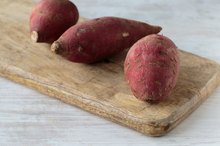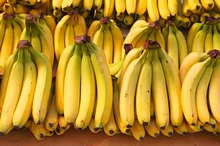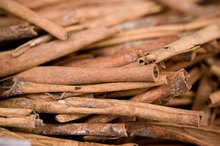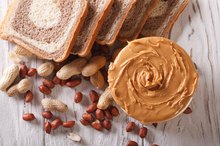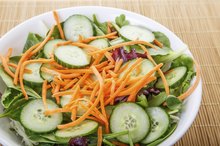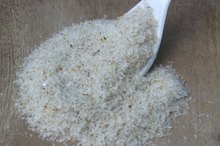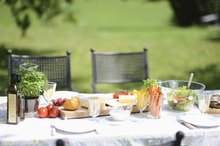What does fact checked mean?
At Healthfully, we strive to deliver objective content that is accurate and up-to-date. Our team periodically reviews articles in order to ensure content quality. The sources cited below consist of evidence from peer-reviewed journals, prominent medical organizations, academic associations, and government data.
- National Cholesterol Education Program: High Blood Cholesterol: What You Need To Know
- National Cholesterol Education Program: High Blood Cholesterol: What You Need To Know
The information contained on this site is for informational purposes only, and should not be used as a substitute for the advice of a professional health care provider. Please check with the appropriate physician regarding health questions and concerns. Although we strive to deliver accurate and up-to-date information, no guarantee to that effect is made.
Triglycerides & Bananas
Triglycerides, a type of fat in your bloodstream, can make you more susceptible to heart attacks and strokes. Food in your diet directly affects the amount of triglycerides in your arteries. Foods high in fat and sugar can elevate your triglycerides to unhealthy levels. Bananas, virtually fat-free and low in sugar, can help you manage your cholesterol levels and protect yourself against cardiovascular disease.
Triglyceride Levels
Keep your triglyceride levels below 150 milligrams/deciliter of blood. In April 2011, the American Heart Association lowered its “best” level of triglycerides to 100 milligrams/deciliter or less. Levels above 200 milligrams/deciliter put you at high risk for heart disease, and levels that go beyond 500 milligrams/deciliter put you at very high risk. To keep you triglycerides at healthy levels, restrict the amount of saturated fat, trans fat, sugar and alcohol in your diet.
- Keep your triglyceride levels below 150 milligrams/deciliter of blood.
American Heart Association Guidelines
Do Sweet Potatoes Raise Cholesterol Levels?
Learn More
The American Heart Association recommends you limit fructose intake to 50 grams to 100 grams daily to lower triglycerides. A medium banana contains 5.7 grams of fructose. You could eat eight bananas without reaching the AHA minimum fructose minimum and 17 bananas without exceeding the maximum. The AHA recommends bananas as a good fruit to eat on a triglyceride-lowering diet 1. It also recommends peaches, grapefruit and cantaloupe. Limit your consumption of dried fruits and super-sweet fruits such as watermelon and pineapple
- The American Heart Association recommends you limit fructose intake to 50 grams to 100 grams daily to lower triglycerides.
Fiber
Bananas protect your heart health in additional ways 1. A medium banana contains 3.1 grams of dietary fiber, making it a high-fiber food. Fiber in your diet can help you lose weight, and shedding unnecessary pounds can help you lower your triglycerides. Dietary fiber can also help lower your low-density lipoprotein cholesterol, also called LDL or “bad” cholesterol. The fiber in bananas can also help lower your blood pressure and blood sugar levels, two important factors in the health of your heart.
- Bananas protect your heart health in additional ways 1.
- Dietary fiber can also help lower your low-density lipoprotein cholesterol, also called LDL or “bad” cholesterol.
Considerations
Is Eating a Lot of Bananas Healthy?
Learn More
Bananas make easy take-along snack foods so you can easily pack one or two in your lunch bag or backpack. You could also make a healthy smoothie with bananas, strawberries, non-fat milk or yogurt and ice. The American Heart Association recommends you limit calories from foods with added sugar to 100 to 150 a day. Bananas can help keep you within guidelines. Top your breakfast cereal with sliced banana instead of sugar. Or, if you make homemade banana bread, add an extra banana to the recipe and use only half the sugar called for in the recipe.
- Bananas make easy take-along snack foods so you can easily pack one or two in your lunch bag or backpack.
- Or, if you make homemade banana bread, add an extra banana to the recipe and use only half the sugar called for in the recipe.
Related Articles
References
- United States Department of Agriculture Nutrient Database
- Bananas, raw. FoodData Central. U.S. Department of Agriculture. Published April 1, 2019.
- Glycemic index for 60+ foods. Harvard Health Publishing, Harvard Medical School. Updated 2020.
- Nutritional Goals for Age-Sex Groups Based on Dietary Reference Intakes and Dietary Guidelines Recommendations. USDA. 2015
- Falcomer AL, Riquette RFR, De lima BR, Ginani VC, Zandonadi RP. Health benefits of green banana consumption: A systematic review. Nutrients. 2019;11(6). doi:10.3390/nu11061222
- Klemm S. Prebiotics and probiotics: Creating a healthier you. Academy of Nutrition and Dietetics. Updated 2020.
- Howarth NC, Saltzman E, Roberts SB. Dietary fiber and weight regulation. Nutr Rev. 2001;59(5):129-39. doi:10.1111/j.1753-4887.2001.tb07001.x
- Pereira A, Maraschin M. Banana (Musa spp) from peel to pulp: ethnopharmacology, source of bioactive compounds and its relevance for human health. J Ethnopharmacol. 2015;160:149-63. doi: 10.1016/j.jep.2014.11.008
- Vitamin C: Fact Sheets for Health Professionals. National Institutes of Health, Office of Dietary Supplements. Updated 2020.
- Hassan AK, Venkatesh YP. An overview of fruit allergy and the causative allergens. Eur Ann Allergy Clin Immunol. 2015;47(6):180-7.
- Manohar M, Verma AK, Upparahalli Venkateshaiah S, Goyal H, Mishra A. Food-induced acute pancreatitis. Dig Dis Sci. 2017;62(12):3287-3297. doi:10.1007/s10620-017-4817-2
Writer Bio
Kathryn Gilhuly is a wellness coach based in San Diego. She helps doctors, nurses and other professionals implement lifestyle changes that focus on a healthy diet and exercise. Gilhuly holds a Master of Science in health, nutrition and exercise from North Dakota State University.
